
The third level is the one that fits most neatly into the old school cyberpunk vision that drove a lot of the Dystopia setting. It’s very high-tech. It has a lot of cyberized-type characters and it contains that “corporations as ultimate authority” idea that everyone remembers from the work of people like William Gibson. That idea later blossomed in the form of games like Netrunner where it’s the Corps vs the Runners; the staid authority vs the rogues of society. The contrast on level Three was that the corporations themselves are the rogues. Unlike in the outside world and in the way they’re presented in Gibson’s work and derivations thereof, the corporations in Dystopia are loose cannons. They’re resisting attempts by their original structures to reclaim the resources (people, technology, data) that most assumed were lost during the Collapse. Once the outside world and those powerful corporations discover that both people and companies are still living/operating inside the city, they’re quite eager to return and try to exploit what it is that’s available. That’s even further reinforced when they discover that those companies still functioning inside have access to technology that vastly outstrips anything outside the city. Like any profit-seeking entity, those corporations want to acquire and sell and utilize that tech for their own gains. But most of the segments of those companies in the city realize that there are ways to exploit all of the above for their own gain and they’d be at the whim of the hierarchy if they returned to the fold. Thus were the Rogue Corps born.
Even distinct as it is from corporations running the outside world, that whole idea is rooted in the concept of corporate oligarchy or corporatocracy. It was an idea that was firmly embedded in my mind from political activity, where it was easy to recognize that both major parties in the United States moved to the tune of whichever major corporation was donating to their campaign war chests. Frequently, those donations went to both parties, so that no matter who ‘represented” the people in our republic, those corporations would have someone(s) attached to a leash. This is, of course, exactly the kind of circumstances we have today which are permanently enshrined in law since the Supreme Court decided that money = free speech. Citizens United permanently established the reality that we had 20 years earlier when I was first writing all of this, since the rule by money is the same now as it was then. But the Rogue Corps are slightly different.

Certainly, they represent a kind of oligarchy on Three because of the absolute control they have over much of the level. Most of them have created what became known in the cyberpunk fiction world as arcologies, which are basically environments that are designed to be worlds unto themselves. Each domain of the major corporations on Three (Metascience, geNETic Industries, The Mandarin Foundation, Global Communications, etc.) is a system that conforms to the activity and technology of the company that has developed it. Each of them are little societies unto themselves that shift and change based on the interests of those who control them; both physically and philosophically. Most of them are accessing the ShadowNet in order to develop much of their technology and that’s why Three is one of the foundational levels of the Net (along with Five and Seven), since they’re not only accessing what filters up from the Walkers and the gangs, but also what they discover on the ever-shifting tableau that is the Net. That near-absolute control means that the presence of the gangs here is, like on Two, more parasitic than actually competitive. The GoreKings operate by stealing resources from Global. Jerry’s Kids function by stealing whatever they can from everyone who’s showing “shine” (tech.)
That’s not as difficult as it might sound because there are other entities on this level that are even more exotic than the Rogue Corps. Most notable among them are the Iron Wizards and the Deathless. The latter and their leader, Koschei, are one of the largest base elements of the background of the setting; alongside their greatest rivals, the Morgue Lords. Unlike the Wizards, the Deathless don’t really exist as a separate group. They’re present in all of the Rogue Corps and some of the gangs, as well; constantly watching, constantly waiting. Their presence is akin to that of many modern corporations, such that the concept of oligarchy doesn’t even need to be overt, so much as simply omnipresent. If it ever feels like modern life can’t function without something provided by a corporate overlord, you’ve found a form of oligarchy. Looking at the little computers in our hands is an example of just that, especially by those given over to the Apple fixation. They exist to shape our world and make us subservient to their profitable interests, in the same way that the Rogue Corps physically shape the air and land around them in their arcologies. Of course, sometimes those interests get beyond the control of even those who create them, such as the Tartarians; one of whom is the primary focus of what might be the third story that Jeff and I publish. Haven’t decided yet. Similarly, the Iron Wizards were a main element of the first real Dystopia story that Fifth Panel ever did, so everything comes back around, eventually.
Anyway, that’s it for now on my casual and infrequent and somewhat vague tour of the city. I’d rather talk about most of these elements in actual stories, rather than spieling them out here like an RPG guidebook. But I thought it was fairly pertinent to our currently degrading government situation to bring up what my concept for corporate control of our lives looks like in the near-disaster future.







 What some consider to be either the ultimate expression of urban decay in America, an encounter with a cosmic phenomenon, or a nightmare writ large. Regardless, it's somewhere between fascinating and lethal and all shades in between.
- Welcome to Hell, the travelers' guide to Dystopia.
What some consider to be either the ultimate expression of urban decay in America, an encounter with a cosmic phenomenon, or a nightmare writ large. Regardless, it's somewhere between fascinating and lethal and all shades in between.
- Welcome to Hell, the travelers' guide to Dystopia.
